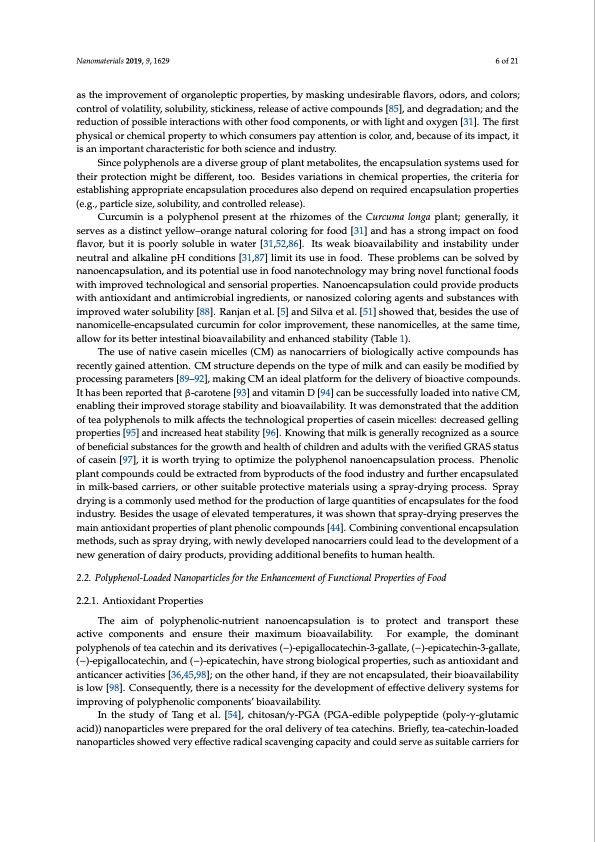
PDF Publication Title:
Text from PDF Page: 006
Nanomaterials 2019, 9, 1629 6 of 21 as the improvement of organoleptic properties, by masking undesirable flavors, odors, and colors; control of volatility, solubility, stickiness, release of active compounds [85], and degradation; and the reduction of possible interactions with other food components, or with light and oxygen [31]. The first physical or chemical property to which consumers pay attention is color, and, because of its impact, it is an important characteristic for both science and industry. Since polyphenols are a diverse group of plant metabolites, the encapsulation systems used for their protection might be different, too. Besides variations in chemical properties, the criteria for establishing appropriate encapsulation procedures also depend on required encapsulation properties (e.g., particle size, solubility, and controlled release). Curcumin is a polyphenol present at the rhizomes of the Curcuma longa plant; generally, it serves as a distinct yellow–orange natural coloring for food [31] and has a strong impact on food flavor, but it is poorly soluble in water [31,52,86]. Its weak bioavailability and instability under neutral and alkaline pH conditions [31,87] limit its use in food. These problems can be solved by nanoencapsulation, and its potential use in food nanotechnology may bring novel functional foods with improved technological and sensorial properties. Nanoencapsulation could provide products with antioxidant and antimicrobial ingredients, or nanosized coloring agents and substances with improved water solubility [88]. Ranjan et al. [5] and Silva et al. [51] showed that, besides the use of nanomicelle-encapsulated curcumin for color improvement, these nanomicelles, at the same time, allow for its better intestinal bioavailability and enhanced stability (Table 1). The use of native casein micelles (CM) as nanocarriers of biologically active compounds has recently gained attention. CM structure depends on the type of milk and can easily be modified by processing parameters [89–92], making CM an ideal platform for the delivery of bioactive compounds. It has been reported that β-carotene [93] and vitamin D [94] can be successfully loaded into native CM, enabling their improved storage stability and bioavailability. It was demonstrated that the addition of tea polyphenols to milk affects the technological properties of casein micelles: decreased gelling properties [95] and increased heat stability [96]. Knowing that milk is generally recognized as a source of beneficial substances for the growth and health of children and adults with the verified GRAS status of casein [97], it is worth trying to optimize the polyphenol nanoencapsulation process. Phenolic plant compounds could be extracted from byproducts of the food industry and further encapsulated in milk-based carriers, or other suitable protective materials using a spray-drying process. Spray drying is a commonly used method for the production of large quantities of encapsulates for the food industry. Besides the usage of elevated temperatures, it was shown that spray-drying preserves the main antioxidant properties of plant phenolic compounds [44]. Combining conventional encapsulation methods, such as spray drying, with newly developed nanocarriers could lead to the development of a new generation of dairy products, providing additional benefits to human health. 2.2. Polyphenol-Loaded Nanoparticles for the Enhancement of Functional Properties of Food 2.2.1. Antioxidant Properties The aim of polyphenolic-nutrient nanoencapsulation is to protect and transport these active components and ensure their maximum bioavailability. For example, the dominant polyphenols of tea catechin and its derivatives (−)-epigallocatechin-3-gallate, (−)-epicatechin-3-gallate, (−)-epigallocatechin, and (−)-epicatechin, have strong biological properties, such as antioxidant and anticancer activities [36,45,98]; on the other hand, if they are not encapsulated, their bioavailability is low [98]. Consequently, there is a necessity for the development of effective delivery systems for improving of polyphenolic components’ bioavailability. In the study of Tang et al. [54], chitosan/γ-PGA (PGA-edible polypeptide (poly-γ-glutamic acid)) nanoparticles were prepared for the oral delivery of tea catechins. Briefly, tea-catechin-loaded nanoparticles showed very effective radical scavenging capacity and could serve as suitable carriers forPDF Image | Polyphenol-Loaded Nanoparticles in Food Industry

PDF Search Title:
Polyphenol-Loaded Nanoparticles in Food IndustryOriginal File Name Searched:
nanomaterials-09-01629.pdfDIY PDF Search: Google It | Yahoo | Bing
Turbine and System Plans CAD CAM: Special for this month, any plans are $10,000 for complete Cad/Cam blueprints. License is for one build. Try before you buy a production license. More Info
Waste Heat Power Technology: Organic Rankine Cycle uses waste heat to make electricity, shaft horsepower and cooling. More Info
All Turbine and System Products: Infinity Turbine ORD systems, turbine generator sets, build plans and more to use your waste heat from 30C to 100C. More Info
CO2 Phase Change Demonstrator: CO2 goes supercritical at 30 C. This is a experimental platform which you can use to demonstrate phase change with low heat. Includes integration area for small CO2 turbine, static generator, and more. This can also be used for a GTL Gas to Liquids experimental platform. More Info
Introducing the Infinity Turbine Products Infinity Turbine develops and builds systems for making power from waste heat. It also is working on innovative strategies for storing, making, and deploying energy. More Info
Need Strategy? Use our Consulting and analyst services Infinity Turbine LLC is pleased to announce its consulting and analyst services. We have worked in the renewable energy industry as a researcher, developing sales and markets, along with may inventions and innovations. More Info
Made in USA with Global Energy Millennial Web Engine These pages were made with the Global Energy Web PDF Engine using Filemaker (Claris) software.
Infinity Turbine Developing Spinning Disc Reactor SDR or Spinning Disc Reactors reduce processing time for liquid production of Silver Nanoparticles.
| CONTACT TEL: 608-238-6001 Email: greg@infinityturbine.com | RSS | AMP |